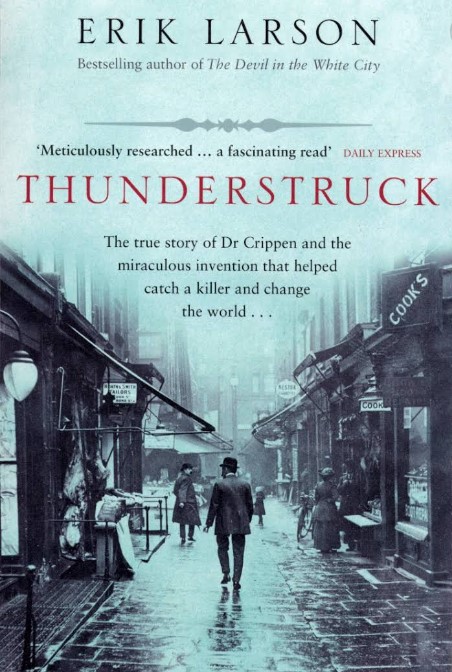Thunderstruck by Erik Larson: “A Ripping Yarn of Murder and Invention.”
Review by Michael Attard
In this non-fiction book, Erik Larson sets out two distinct stories that appear to have no connection to each other. And it is also the case that the large cast of characters in each story never meet each other, nor do they ever have any desire or reason to meet. Yet, while one protagonist is crucial to the downfall of the other, the second protagonist is significant in the success of the former.
The time in question roughly spans the last decade of the 19th century and the first decade of the 20th century. The heart of the story takes place in England. It is the end of the Victorian era and the transition to the more open reign of Edward VIII.

On page four, we learn that there has been a gruesome murder, the details of which have captivated the minds and imagination of millions of people around the globe. But that line is left dangling, and we are introduced into the world of 19th-century physics. Our first protagonist is the famous Italian inventor Guglielmo Marconi. The author’s concise descriptions create a desire to know more. On the other hand, the scientific background presented will not be of interest to all readers, but I found it to be brief enough to enhance the story rather than detract from the main themes and plot. The crux of Marconi’s work may escape our 21st-century, technologically savvy minds. However, it was the case that “in 1894, no means existed for communicating without wires over distances beyond the reach of sight.” And this was Marconi’s quest.
The author continually switches back and forth between stories. We learn about Marconi’s scientific successes and failures, as well as his sometimes socially obtuse character and personal romances. I found the more interesting story to be about a Dr. Crippen. The author’s way with words makes the reading easy. In his description of the doctor, he says, “Crippen was lonely, and genetic fate had conspired to keep him that way. He was not handsome, and his short stature and small bones conveyed neither strength nor virility. Even his scalp had betrayed him, his hair having begun a brisk retreat years before.” Nevertheless, the doctor had met a woman who later called herself Belle, and even though they were poles apart in virtually every way, they married. Throughout the book, we are reminded that to those who knew them, the couple appeared quite happy with each other.
Marconi, on the other hand, is consumed by his work and his romances fail. Possibly, as with the scientific background, many readers will not be interested in the author’s description of the times or the details pertaining to the growth of Marconi’s company.
Despite Dr. Crippen’s shortcomings, and his marriage to Belle, he and a younger woman named Ethel fall in love. Then one day, Crippen announces that his wife has run off to America and that he never expects her to return or to see her again. However, there are too many clues that something is not quite right with Crippen’s story, and Belle’s friends take their concerns to the police. The detectives conclude that Crippen’s and Ethels’ “responses and actions, indicate no deception at all.”
Marconi’s company was struggling financially. His “transatlantic service was slow and fraught with problems […] But the system worked.” In fact, in 1909, Marconi won the Nobel Prize for physics. And yet, people were still not impressed, nor did they see any real compelling use for Marconi’s invention. After all, there already was an undersea cable crossing the Atlantic that connected Europe to the Americas. Why bother with wireless?
A body was found buried in the cellar of the Crippen home. But the doctor was gone, and many parts of the body were missing, making it impossible to determine whether the remains belonged to a man or a woman. Also, there was no way of knowing how the person had died.
I do not think that I am giving much away here, as a criticism of the book might be that, from early on, the reader does not need to be much of a detective to ascertain who the victim is and who the murderer is. In that sense, the book is not a murder mystery. For some, this may be a failing. But, in fact, the real mystery all along is how these two stories, that of Marconi and that of Crippen, are connected. That is the ongoing, confusing part.
It was July 1910, and the captain of the SS Montrose was preparing his ship for a routine voyage from Antwerp to Quebec City, Canada. Despite the age of the vessel, it had been installed with a wireless system. Three hours into the voyage, the captain saw something that he thought was “strange and unnatural.”
Thus began waves of wireless messages across the Atlantic during the SS Montrose’s eleven-day voyage. Millions of people tuned in to the news of the chase, while the pursued couple was oblivious to the reality that the whole world through the wonder of wireless was right on their tail.
For Marconi and his company, it was a murder that finally convinced the sceptics that wireless was a practical tool.
And what of Dr. Crippen and Ethel? It is in the epilogue.
The Reviewer
Michael Attard is a Canadian who has lived in Gwangju since 2004. Though officially retired, he still teaches a few private English classes. He enjoys reading all kinds of books and writes for fun. When the weather is nice, you may find him on a hiking trail.




